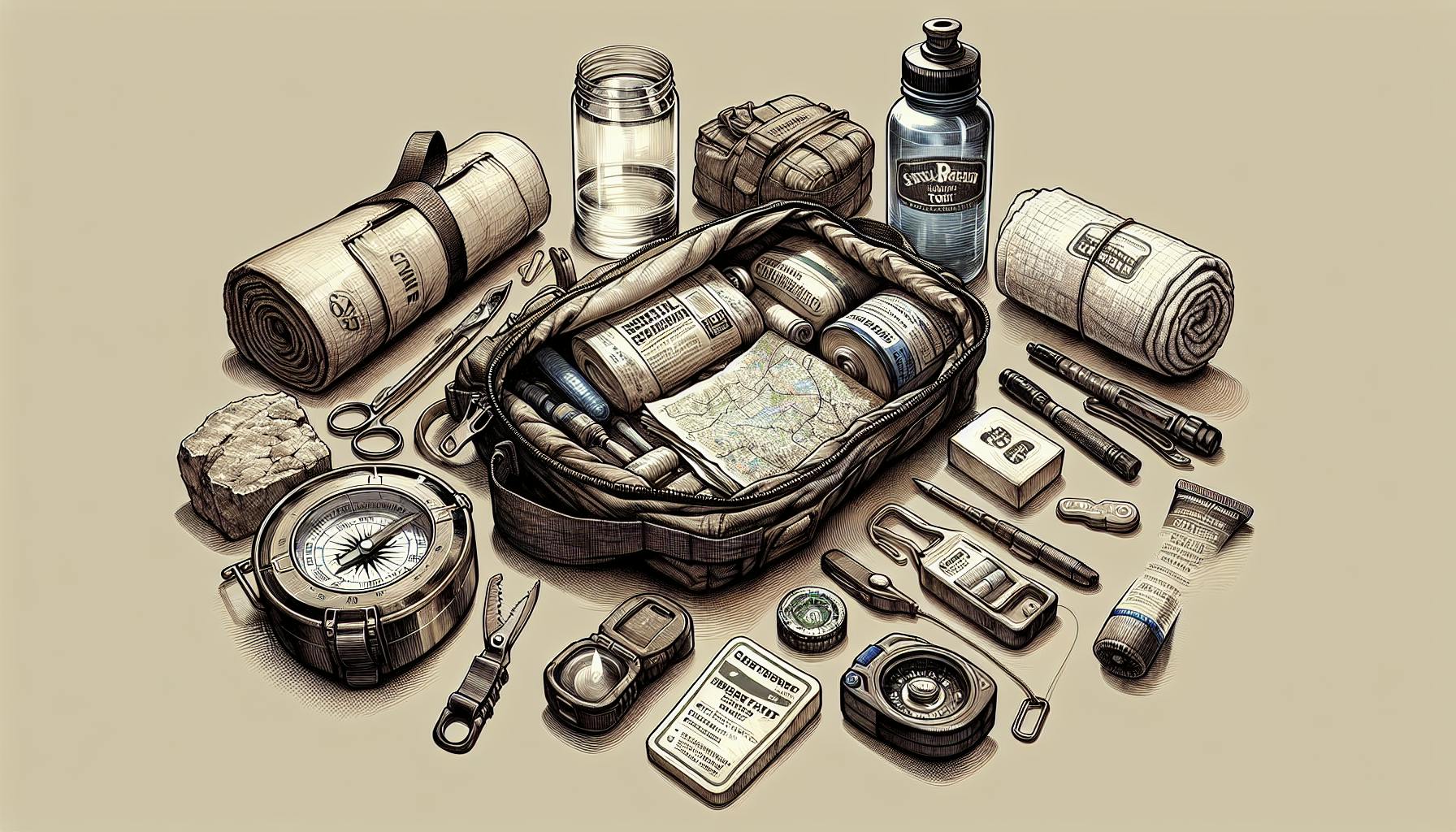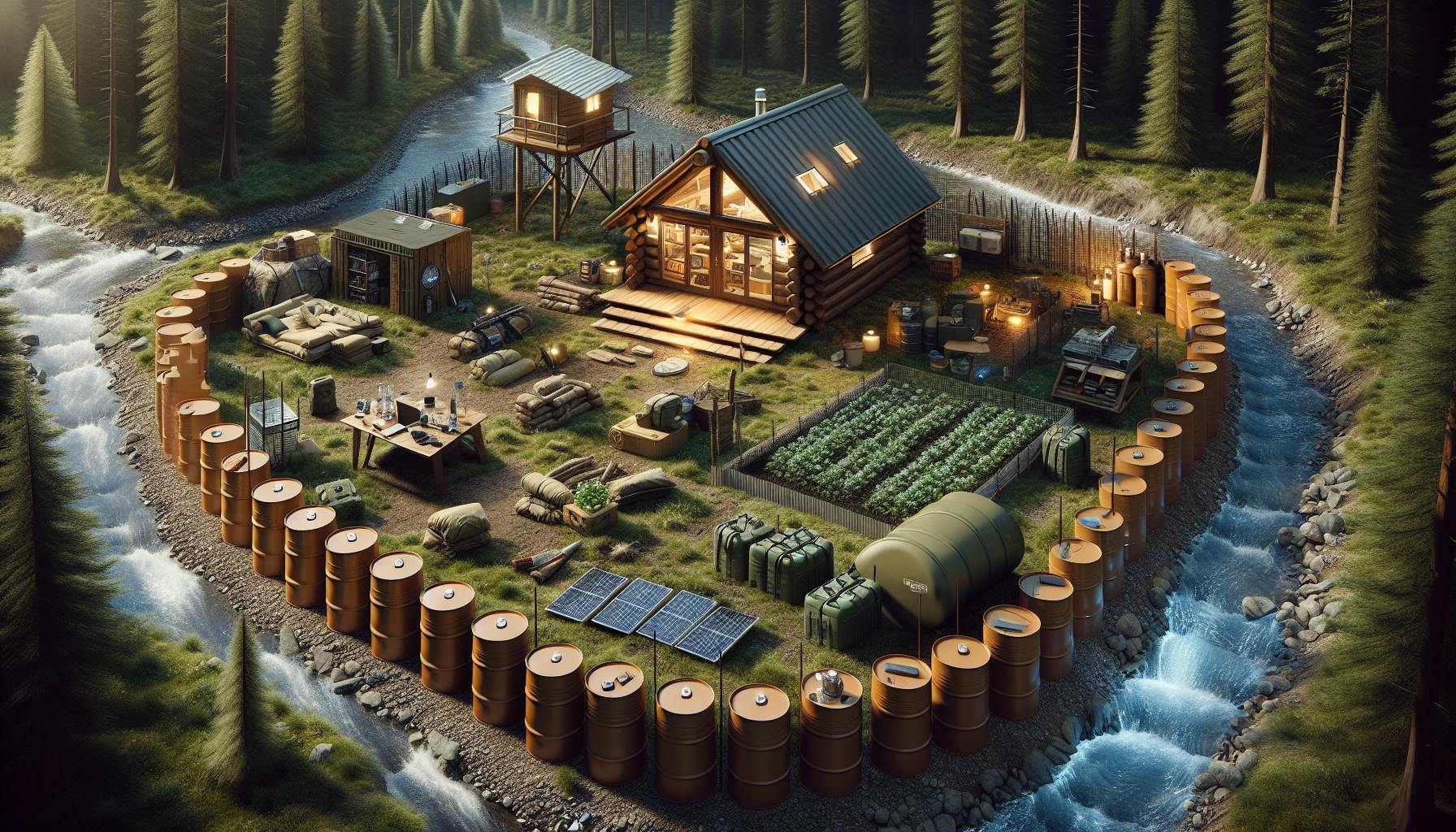When it comes to preparing for an emergency, having a long-term food supply is crucial. Most would agree that having food with a 25-year shelf life provides needed sustenance in a crisis.
The good news is that with the right storage methods and food choices, achieving a 25-year shelf life is possible. In this article, you'll discover the best practices for acquiring and preserving high-quality survival food that can nourish your family when you need it most.
You'll learn key criteria for selecting nutritious food kits tailored for long-term storage. We'll explore optimal preservation techniques to maximize shelf life, along with storage solutions to maintain food safety and quality. You'll also find economical tips for building your 25-year food supply without breaking the bank.
Ensuring a Sustainable Food Supply
As preppers, having a reliable, long-term food supply is essential for emergency preparedness. When selecting survival food for your stockpile, prioritizing options with a 25-year shelf life ensures you can depend on nutrients and safety for decades to come.
Understanding the Importance of a 25-Year Emergency Food Supply
When building your food storage, the 25-year mark for shelf life indicates the food inside will remain edible and nutritious over an extended duration. This enables you to store rations for your household confidently during a crisis scenario. Calculate at least 2,000 calories per person daily when determining the quantity needed for your family size.
Selecting the Best Survival Food Kits for Long-Term Storage
Seeking out high-quality survival food supports longevity. Search for kits with minimal processing that use recognizable, natural ingredients. Transparent labeling from reputable emergency food brands provides confidence in what you’re storing.
Maximizing Shelf Life Through Optimal Food Preservation Techniques
Storing your survival food properly helps maximize shelf life. Keep kits in a cool, dark place around 60-70°F. Use airtight containers like food-grade plastic buckets to prevent moisture and oxygen exposure. Rotate stock routinely while checking for signs of spoilage. Practicing first-in, first-out inventory management maintains safety too.
What survival food has the longest shelf life?
Freeze-dried meat is considered the ultimate long-term protein source when it comes to survival food. With a shelf life of over 25 years when stored properly, freeze-dried meat outlasts any other type of food. Here are some of the key benefits of stockpiling freeze-dried meat as part of your emergency food supply:
-
Extremely Long Shelf Life: Properly packaged freeze-dried meats can last 25+ years. This makes it perfect for extended emergencies when you may need protein after other foods have expired.
-
Lightweight and Portable: Since the water has been removed, freeze-dried meat is very lightweight. It's easy to transport if you need to bug out. Rehydrating it is simple when you have access to water again.
-
Nutritious: Freeze-drying locks in most of the nutrients found in fresh meat. So you still get an excellent source of protein, as well as vitamins and minerals. Studies show rehydrated freeze-dried meat contains up to 98% of the nutritional value of fresh meat.
-
Easy to Prepare: All you need is boiling water to rehydrate freeze-dried meat back to a texture and taste close to normal. Then you can cook it as usual or eat rehydrated.
With its exceptionally long shelf life, freeze-dried meat is quite simply the best survival food option for ensuring you have a lasting protein supply after SHTF. It belongs in every prepper's emergency food stockpile.
How does survival food last 25 years?
Most survival food designed to last 25 years utilizes dehydration and freeze-drying preservation methods. These processes help extend shelf life by reducing moisture exposure.
When stored properly in protective containers and pouches, 25-year survival food avoids excess contact with air and humidity. This enables the food to remain edible for decades.
Some best practices for maximizing survival food shelf life include:
- Storing in cool, dark spaces to prevent temperature fluctuations
- Using oxygen absorber packets to regulate moisture and oxygen levels
- Placing food in Mylar bags or food-grade buckets for added protection
- Following all storage guidelines from manufacturers
By leveraging modern food preservation technology and proper storage methods, shelf-stable survival food can retain nutrients, taste, and edibility for exceptionally long periods, keeping your emergency food supply intact when you need it most.
What food can be stored for 30 years?
When building an emergency food supply, it's important to include foods with a long shelf life that will sustain you and your family in a crisis. Some of the best options for long-term storage include:
Wheat - Hard red or white wheat can last 30 years or more when properly stored in airtight containers in a cool, dark place. Wheat berries can be ground into flour for baking or cooked as-is.
Rice - White rice has an almost indefinite shelf life when kept dry and sealed. Brown rice has a shorter lifespan of only about 6 months. Rice is versatile and can accompany other foods.
Beans - Dried beans like pinto, black, garbanzo, kidney, etc. can easily last 30 years with proper storage. They are packed with nutrition and fiber. Beans need to be soaked before cooking.
Oats - Steel cut or rolled oats can last 30 years when stored in moisture-proof containers. Oats provide carbohydrates, protein and fiber.
Pasta - When kept dry and cool, pasta can last 30+ years. It tends to be filling and can serve as a base for many easy meals.
The keys are keeping food sealed airtight, stored in a cool, dark space around 60-70°F. Avoid temperature fluctuations. Inspect periodically for signs of moisture or spoilage. With sound storage practices, these basics can sustain you for decades.
How do you preserve food for 25 years?
Preserving food with a 25-year shelf life requires careful planning and preparation to ensure quality and safety. Here are some best practices:
Use Proper Packaging
Mylar bags with oxygen absorbers are an excellent option for blocking out light and removing oxygen. Make sure to seal the bags thoroughly after removing as much air as possible. This prevents oxidation and bacteria growth.
Store in Optimal Conditions
A cool, dark, and dry location is ideal, like a basement or root cellar. The temperature should remain fairly consistent, around 60-70°F. Drastic temperature swings can impact food quality over time.
Rotate and Inspect
Every 6 months, inspect stored food for signs of spoilage, insect infestations, or damage. Rotate stock using the first in, first out method. This ensures you utilize food before it expires.
Properly stored foods like grains, beans, nuts, and some freeze-dried items can remain viable for 20-30 years. However, flavor and texture may degrade over extremely extended durations. Test older items periodically to ensure edibility and nutrition. With careful planning, you can build an emergency food supply to sustain your family when needed most.
sbb-itb-b932644
Best Practices for Acquiring a 25-Year Emergency Food Supply
When looking to purchase a long-term emergency food supply, it's important to evaluate different options carefully based on key factors like taste, nutrition, ingredients, and cost-effectiveness. This ensures you select a high-quality kit tailored to your family's needs and budget.
Evaluating the Best Survival Food 25 Year Shelf Life Options
Focus on food quality when researching different 25-year emergency kits. Look for meals, especially proteins, that retain decent flavor and texture after years in storage through freeze-drying or other preservation methods. Test samples if possible. Kits with very bland or unappealing food often go to waste.
Prioritize variety across entrees to avoid taste fatigue. Having different flavors, from savory stews to sweet breakfast options, makes daily rations more palatable over time.
Also examine ease of preparation and cooking requirements. Some kits offer ready-to-eat options to conserve fuel, an important consideration for off-grid survival.
Assessing Nutritional Value for Emergency Preparedness
The daily nutritional content of your stored food directly impacts health, especially for children and seniors. When comparing emergency kits, analyze key micronutrients:
- Protein: Look for at least 15-20g per serving for maintaining strength and immunity.
- Fiber: Choose options with 5-10g to support digestion.
- Vitamin C: Critical for wound healing and preventing scurvy.
- Iron, zinc etc.: Minerals to boost immunity and energy levels.
Pay attention to caloric values as well - the average adult needs 1500-2000 calories in survival scenarios.
Ingredient Transparency and Food Quality
Always research exactly what goes into your survival food to best provide wholesome, nutritious meals.
Favor brands using mostly recognizable ingredients - vegetables, grains, legumes etc. Be wary of excessive preservatives or artificial additives that erode quality.
Also look for USDA-certified gluten free, kosher, non-GMO or vegan options if required for your family. Carefully check nutritional labels for allergens.
Cost-Effectiveness: Getting the Best Value for Your Prepper Supplies
To calculate true value, determine the cost per full day's worth of food or cost per calorie across different kits.
For example, a 30-day kit with 900 calories per day priced at $297 breaks down to:
- $9.90 per day
- $0.33 per calorie
Whereas a $349 kit with 1200 daily calories for 60 days equals:
- $5.82 per day
- $0.29 per calorie
Despite the higher upfront price, the second option proves more cost-efficient and a better emergency food value overall.
Doing these calculations allows an apples-to-apples comparison so you can invest wisely.
Long-Term Food Storage Solutions
Properly storing long-term survival food is crucial to maintaining quality and extending shelf life up to 25 years. Following best practices for storage containers, environment, organization, and preparation access will keep your food fresh while ensuring disaster readiness.
Choosing the Right Storage Containers for Shelf-Stable Food
When selecting containers for long-term food storage, opaque plastic buckets with gasket seals or thick multilayer Mylar bags work best. Key features to look for include:
- Air tight seal to prevent oxygen exposure
- Blocks light to avoid vitamin degradation
- Food-grade plastic for safety
- Stackable for space efficiency
- Durable for protection
Mylar bags have the added benefit of pairing with oxygen absorbers to remove oxygen from the packaging, further extending shelf life.
Maintaining a Cool, Dry Storage Environment for Food Preservation
Storing survival food properly is critical to maximize longevity. Ideal conditions are:
- Stable temperatures between 60-70°F
- Low humidity around 30% RH
- Good air circulation
- No direct sunlight
Basements, cellars, climate-controlled rooms are excellent options. Avoid places with frequent temperature fluctuations or moisture issues.
Effective Inventory Management for Disaster Readiness
Organization is crucial when storing food long term. Best practices include:
- Catalog items in a spreadsheet noting product names, purchase dates, best-by dates, storage locations
- First In, First Out (FIFO) inventory rotation
- Label storage containers with contents and dates
- Take periodic inventory counts checking for damage
Proper tracking and rotation ensures you have full visibility of your emergency food supply and that older food gets used first before expiry.
Preparing for Mealtime: Ensuring Access to Cooking Equipment and Fuel
When disaster strikes, you’ll need more than just food supplies. Also vital for survival preparedness:
- Camp stoves, grills for cooking without power
- Fuel sources like propane, gasoline, wood, charcoal
- Pots, pans, plates, utensils
- Can openers, mess kits
- Water filtration for drinking, cleaning
Stock up on the critical cooking equipment, fuel sources, and other gear to sustain daily meal preparation when normal infrastructure fails.
Following proper protocols for long-term food storage using appropriate containers, environment, organization, and preparation access will help ensure you can rely on your emergency food supply being intact and safe to eat for years to come. The ability to sustain yourself and your family in a disaster directly depends on it.
Specialized Focus on Freeze-Dried and Dehydrated Food
When stockpiling food with a 25+ year shelf life, freeze-dried and dehydrated items require special handling and storage considerations. Following best practices will help ensure your emergency food ration bars, meals, and ingredients maintain peak quality and nutritional value over time.
Securing Nutrient-Rich Freeze-Dried Food for Emergency Food Ration Bars
Freeze-dried foods are delicate prior to proper storage. Exposure to oxygen and moisture causes oxidation, compromising nutrients. When preparing your emergency food supply:
- Seal freeze-dried items in mylar bags with oxygen absorbers immediately after opening.
- If repackaging from bulk, wear gloves and work quickly to limit air exposure.
- Prior to sealing, insert a desiccant pack to control moisture.
- Store sealed bags in cool, dark spaces like basements or cellars.
Following these steps prevents degradation, retaining essential vitamins and minerals in your freeze-dried ingredients over decades.
Mastering Proper Rehydration Techniques for Dehydrated Food
To fully restore freeze-dried or dehydrated foods:
- Carefully measure recommended water amounts. Too little water leaves food crunchy; too much makes it soggy.
- Bring water to a boil for meals. For fruits, soak in cool water.
- Stir gently while rehydrating to evenly distribute moisture.
- Allow sufficient time for full rehydration based on food density before consuming.
Practicing proper rehydration ensures you get the most nutrition and enjoyment from meals and ingredients after long-term storage.
Preventing Clumping in Your Long-Term Food Storage
Over years of storage, freeze-dried items can clump together due to ambient moisture in containers. To prevent this:
- Use airtight bins with gasket seals when storing items like grains, fruits, vegetables.
- Include several desiccant moisture-absorbing packets in each storage container.
- Regularly check containers and replace desiccants as needed.
With the right storage protocols, your nutritious freeze-dried and dehydrated foods will remain loose and edible for emergency use decades into the future.
Economical Strategies for Building Your Emergency Food Supply
When building your emergency food supply, it's important to find cost-effective solutions to stock up on enough non-perishable food to meet your household's needs. Here are some economical strategies to consider:
Leveraging Bulk Purchases for Cost Savings at Retailers Like Costco
Buying freeze-dried or dehydrated survival foods in bulk units often costs significantly less per ounce compared to smaller quantities. Check warehouse stores like Costco for large buckets or #10 cans of foods with 25+ year shelf lives. The savings per meal can really add up over time.
Utilizing Group Orders to Access Wholesale Prices
Consider coordinating a group order with other preppers in your area to buy very large quantities of emergency rations at wholesale prices. When purchasing hundreds of pounds of food at once directly from suppliers, the bulk discounts can be substantial. Just make sure to thoroughly vet any new products before purchasing.
Keeping an Eye on Online Deals: 25-Year Emergency Food Supply Amazon Price Tracking
Sign up for price tracking services like CamelCamelCamel to receive alerts when the emergency food kits and supplies you’re watching on Amazon have a price drop. Snagging deals as they pop up is a great way to slowly build your food stockpile without breaking the bank. Automated alerts remove the manual effort of checking for sales.
Taking advantage of bulk pricing and online deals takes some extra effort, but pays dividends through lower per-meal costs. Building up a robust 25-year emergency food supply takes forethought and planning, but doesn't have to drain your bank account. What other economical tips do you utilize when stocking up on long-term storage rations? Let me know in the comments!
Conclusion: Mastering Disaster Readiness with a 25-Year Shelf Life Food Supply
Having a reliable stock of long-lasting emergency food is a crucial part of any preparedness plan. By researching reputable brands, utilizing proper storage methods, and budgeting wisely, you can ensure your family has access to nutritious food with a 25-year shelf life when disaster strikes.
The keys are finding high-quality products, keeping them stored safely, and rotating your supply so it stays fresh. With some diligent planning, you can rest easy knowing you've got hearty, healthy meals ready to go if normal access to food is disrupted.
Recap of Best Survival Food 25 Year Shelf Life Practices
-
Research top brands thoroughly and read reviews before purchasing. Focus on tasty, nutrient-dense options.
-
Properly store food as directed, in cool, dark, and dry places to maximize shelf life.
-
Budget wisely and build your supply gradually if needed. Aim for variety and enough calories.
-
Rotate stock routinely to use older items first and refresh with new purchases.
-
Store food safely away from temperature extremes and pests that could spoil it.
-
Check storage areas periodically to ensure ideal conditions. Discard anything spoiled.
Final Thoughts on Preparing an Emergency Food Supply for a Family of 4
When prepping food for a family, tailor your supply to provide balanced nutrition for all members. Calculate the calories needed per day for each person's age, gender, size, and activity level.
Shop for a diverse mix of proteins, fruits/veggies, grains, and some comfort foods. Having options and the ability to prepare different meals is important for morale.
Build up a 3-6 month supply gradually if needed. This gives adequate reserves for weather disruptions, supply chain issues, or other short-term crises.
Rotate and refresh food routinely so nothing expires before you need it. By mastering long-term food storage, you can keep your family nourished in an extended emergency.


